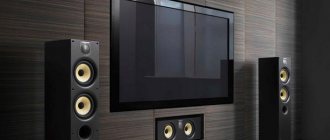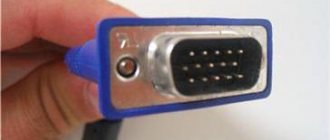The functionality of laptop computers is enormous: playing video and audio content, 3D games at optimal settings with maximum quality, communicating on the Internet, watching streaming videos from YouTube. If you have a home theater, the user can combine two monitors and turn the speaker system into a media center. To do this, you need to properly connect expensive equipment to each other. To make the connection as quickly as possible, use our recommendations.
Connecting using a VGA connector
To connect a home acoustic system to a laptop computer, you need a cable with a standard RCA socket (tulip) and a Mini-jack with a diameter of 3.5 mm. To make the image from the monitor appear on the big screen, insert the cable with “tulips” into the “aux in” connector on the TV, and the “mini-jack” into the corresponding socket on the laptop.
The disadvantages of this connection include poor-quality video signal transmission.
Important! The VGA connector transmits analog signal and video with a resolution of no more than 1600x1200 pixels.
Connecting using an HDMI connection
After selecting the desired wire, to connect the devices, connect them with a cable, making simple settings.
Connection procedure:
- Turn off your devices.
- Connect one end of the wire to the HDMI input port on your personal theater receiver, and the other end to the HDMI output port on your laptop.
- Turn on the equipment.
- In the speaker system settings, select the desired jack and set it as the signal source.
- To configure your PC, right-click on the screen and select the “Screen Resolution” option from the drop-down list. Set one of the commands: expand the image to both displays, turn on one of the screens, duplicate the video image.
If the monitor is on a high-definition home theater (HDTV), then the video can only be seen on the TV screen, and not on the laptop display. To see elements on your laptop monitor, turn off your personal cinema.
If this jack is not available, use an adapter that can be used to connect the HDMI connector of the speaker system to the USB port of your laptop. However, this will result in loss of image quality.
Features of connecting a home theater to a computer
- it is easier to connect equipment from one manufacturer, since the connector format is the same or easily compatible;
- old ports (VGA, DVI) transmit only video content, so other connectors must be additionally used to transmit an audio signal;
- if the picture or sound quality is unsatisfactory, try updating or reinstalling the video card;
- The latest operating systems automatically recognize the equipment that is connected and allow you to use several monitor screens at once. Outdated versions of the OS require additional installation of disks or some files;
- When purchasing a cable, keep in mind that the length must be sufficient to connect the home theater to the laptop.
Home theater speakers
How to turn on DVD speakers? The most common home theater speaker system includes at least five speakers and one subwoofer. The speaker outputs are strikingly different from those connectors with which the sound card of a personal computer is equipped.
Is it possible to somehow “outwit” a home theater and connect the whole thing directly to a laptop or desktop computer? Undoubtedly! To do this, you need to familiarize yourself with several stages of connection and settings.
The most convenient way to eliminate all misunderstandings is to use an amplifier. It can be used to connect all devices. Any DVD player is perfect for this role:
- Take a cable that has “tulip” connectors on one side and the most common 3.5 mm minijack on the other side.
- The player simply connects to the output of the computer's audio card, namely, the output that is responsible for connecting to the speakers.
Important! This input is usually indicated in green, and in some cases it will be labeled with the word “out”, which means “exit”.
- The output of the “tulips” must be connected to the sockets of the DVD player.
Important! The pin itself is indicated in red and white with the mark “in”. Most often, the above cable should be included with your home theater system, but if it is not available, you can always buy it cheaply at electronics stores.
Now we have come to the second stage of connection - connecting the speaker system to an amplification device. For this we need the cables included in the kit. Using them, we connect all the acoustics to the player, matching all the inputs and sockets. You are unlikely to get confused, since each entrance is marked differently.
How to connect speakers from a home theater to a laptop? We are almost at the answer to this question. Let's move on to setting up the equipment.
In the Windows operating system, you need to go to the menu with the settings of your sound card. This menu is located in the Start panel. You need to go to the section where there are controls for all audio outputs and inputs. There you need to indicate that six columns will be used.
Important! The program will automatically adjust the sound of the acoustics. Now all that remains is to launch the player, select the desired audio input channel and enjoy the clear sound that will now always be on your computer.
Review. Krell Vanguard Universal DAC. The most versatile DAC
Not so long ago, the difference between a network player and a DAC was quite obvious - the player immediately provided you with an analog output, and you could connect it to your local network on the one hand, and to an amplifier on the other. The DAC required a separate digital source, but provided extensive switching capabilities.
In both cases, we had some compromise, but at the same time we had no idea what the solution would be. And not so long ago, devices began to appear that could not be called either a player or a DAC, in the strict sense of the word. Progress in the miniaturization of digital sources and their transfer to the ARM platform has made it possible to place this module directly in the DAC housing without sacrificing the switching capabilities of the latter.
Today I’m testing just one of these devices – the Krell Vanguard Universal DAC. And the key word in the name of this DAC is Universal, that is, “universal”. And this is truly one of the most versatile devices I have ever seen.
Promoted
Real and “virtual” multi-channel audio
A true multi-channel audio track puts voice into the center channel and effects and music into the rear and front speakers. Or - in accordance with the distribution during recording (in some multi-channel audio standards).
“Virtual” multi-channel audio is distributed according to the spectral characteristics of the reproduced sound. Software and hardware parse the signal into components according to predetermined algorithms, and distribute sounds around the listening point, creating surround sound.
Possible problems and their solutions
Now let's look at common connection problems and suggest ways to solve them.
I can't hear any sound or pictures after connecting my home theater system to my computer
If you encounter a similar problem, we recommend the following:
- Check the serviceability of the equipment and cables involved.
- Check that the wires are connected correctly.
- If this does not help solve the problem, delve into the computer settings. We go into the settings of the PC/laptop sound card and check that the configurations are correct. As a rule, one of the proposed actions always helps resolve the problem that has arisen.
We connect equipment via Wi-Fi, but the computer does not see the home theater
To solve the problem, we recommend checking that the router is working properly. Please also note that you must connect to the same wireless network. Recheck the connection and, if necessary, reconnect.
Cable comparison
Both the computer and the TV are connected to the home theater, but the sound or image is not reproduced: what is the reason and how to solve the problem?
The cause of this malfunction is most often a device conflict. But don’t despair, it can be resolved painlessly.
To restore sound, we connect equipment (TV and home theater) using an optical cable; and for a high-quality image, connect the computer and TV with an HDMI cable.
As a rule, devices are equipped with a corresponding connector. Connecting in this way will allow you to separate the video and audio signals. After which the devices will no longer conflict. As a result, we get high-quality image transfer from the computer to the TV, and surround sound from 5.1 acoustics.
Connecting a 5.1 system to a PC
As you can see, the process of connecting a home theater to a computer is not too complicated. The main task is to decide on the “Given”, that is, the technical characteristics of the devices, and the presence of the appropriate connectors. Otherwise, the process of wired connection and settings is quite similar.
Prioritizing traffic on the router - setting up QoS
Today everything is not connected to Wi-Fi: computers, household appliances, smartphones and tablets. It is not surprising that the connection speed sometimes begins to “sag,” even if your router is the only one in the next 100 meters. But it’s one thing to see a drop in speed when downloading a large file in the background, and quite another thing to experience the same thing, but when watching a movie. It is quite logical that there is a desire to distribute the load on the network between different consumers, and this can be done using QoS (Quality of Service) technology.
Setting up QoS on a router is easy. To do this, you need to enable the service, and then configure rules for each type of Internet activity:
QoS should not be confused with bandwidth control. In the latter case, the router limits the bandwidth for some clients to a clearly defined number. And even if the channel is completely free, the client will not be able to download at a speed higher than the specified one. And QoS operates on priorities: if a client has a low priority, but the channel is empty, it will be connected at maximum speed, which will drop as soon as a client with a high priority connects.
Alas, not all routers have QoS support. In addition, QoS will not help if the reason for the drop in speed is not the simultaneous connection of many devices to the router, but the congestion of the range with other Wi-Fi networks. In this case, changing the band (if the router is dual-band and the client has 5 GHz support) or connecting the client with an RJ-45 cable will most likely help.
“Chinese box” or full-fledged receiver?
In fact, the choice is ambiguous. If you need to connect several devices into a single system, the choice is obvious.
However, buying a receiver will hit the budget hard, and if there is no need to scale the entertainment system, it will become an unjustified waste. The box copes with the tasks quite well if it is necessary to connect acoustics and a single sound source.
(4.88 out of 5, rated: 8)
Why is the connection made?
The home theater is connected to improve the acoustics. You will watch videos and hear the highest quality sound from movies, videos and music. And most importantly - support with a big picture. You will be able to watch movies from any site, including YouTube.
And watch absolutely any films, and completely free of charge, compared to satellite TV. Advertising will not constantly bother you, and you can watch a missed series or match at a time convenient for you. The games will be as realistic as possible, but in this case it is better to use a computer.
What to do if there is no sound after connecting your home theater to your PC
To make the sound of movies you watch on your computer more spacious, you can connect a DVD player and speakers to the machine. To do this, you need a cable with tulips at one end and a minijack at the other; as a rule, it comes with the cinema.
Step-by-step connection instructions:
- Insert tulips into the player's IN socket.
- Insert the minijack into the free slot for the sound card into the PC system unit.
- After connecting, go to the sound card setup menu.
- In the sound settings, note that 6 speakers are now used.
After scanning is completed, you can enjoy high-quality sound through your speakers. Now the sound waves will be correctly distributed to each speaker, creating surround sound in the room.
This method is quite easy and allows you to watch online movies and play games with high-quality sound. In this case, nothing changes fundamentally, and the recreation center acts only as a sound amplifier. Of course, you don’t need to buy new equipment specifically for this method, but you can use an old player that has not been used for a long time.
If after connecting there is no sound on the PC, you should try restarting the OS and checking the operation of the equipment. The operating system may not have automatically identified the new hardware as the default.
In the task area, using RMB, click on the speaker icon and select “Playback devices”. In the list that opens, highlight the hardware type (5.1) and click the “Default” button. Use "Apply" and "OK" to save the configuration.
REFERENCE! In the same window, by pressing the “Properties” button, you can further configure the operating parameters by switching between tabs (balance, effects, etc.).
Another reason for the lack of sound may be the lack of setting the required channel on the player. Go to the amplifier menu and activate the audio channels used. This can be done by selection.
Conflicts between different devices are possible when all components are used: speakers, TV, receiver. To resolve the issue, it is necessary to separate the video and audio signals. For this:
- We connect the receiver to the TV via an optical cable (the problem with sound is eliminated).
- We connect the TV and PC with an HDMI cable.
We examined in detail the methods of connecting a computer and a home theater. We hope that the article answered all readers’ questions on this topic.
The computer is the main one, you watch movies on it, and the set of speakers is just an amplifier for higher quality sound. This scheme is most relevant for older home theater models that are less functional. To connect, you need to use a cable with two tulips on one end and a mini-jack connector on the other.
As a rule, such wires are included with the home theater system.
- We connect the tulips to the DVD player into the “Input” (IN) socket.
- On the computer, insert a mini-jack into the free socket of the sound card.
- We carry out some manipulations with the settings: it is necessary to define the cable that appears as an output for 6 speakers.
The sound will be automatically distributed to the desired speaker, creating surround sound in the room.
Despite its simplicity, the first type of connection has its advantages. Actually, ease of connection is the main one. In addition, no additional elements are required. This way you can watch movies online or play computer games and enjoy good sound. There are no disadvantages as such, but it can be noted that with such a connection nothing functionally changes: the home theater only allows you to improve the sound quality.
It makes no sense to specifically buy a new system for such a connection to a PC only if you already have a player that has been idle for a long time. Otherwise, it is more profitable to invest money in upgrading your computer: to connect good acoustics, you should buy a powerful sound card.
After connecting the speaker system to the computer, you will need to perform simple setup. It is necessary to indicate in the PC settings that for sound reproduction it is not a stereo system that is used, but 5.1 acoustics.
To do this, you can use standard Windows tools or programs installed when installing drivers on the sound card. In most cases, this is the Realtek manager, but there are other applications. You can find the icon in the tray at the bottom right of the screen or in the Control Panel.
You need to open the section in which you manage audio inputs and outputs and indicate that the audio signal is now broadcast not to two, but to 6 speakers. Next, if the connection was made through the receiver, you need to open its settings and indicate through which audio input the sound signal is received. To check how the connection works, you need to start a movie or music on your computer.
READ MORE: Do-it-yourself hammock chair, we make a hanging hammock chair using a macrame pattern. Master class and step-by-step instructions for making a wicker hammock chair from a fabric hoop.
Conclusion To hear the best quality sound while watching a movie or playing music, you need to know how to connect your home theater speakers to your computer. This can be done in several ways: through a DVD or Blu-Ray player, or directly to the sound card.
Sometimes this requires purchasing one or more additional cables. After the equipment is connected by cable, you need to perform a simple setup. Now high-quality surround sound will be played through the speaker system.











